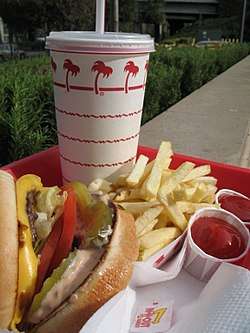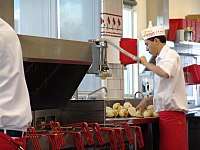In-N-Out Burger products
When In-N-Out Burger first opened in 1948, the company only provided a basic menu of burgers, fries and beverages. The foods it prepared were made on-site from fresh ingredients, including its french fries which were sliced and cooked to order. Unlike other major competitors in the hamburger fast food restaurant business (Burger King, McDonald's and Wendy's), as the chain expanded over the years, it has not added products such as chicken or salads to its menu since 1976 and has never changed its preparation methods.
The company utilizes a vertical integration model for its raw ingredients, procuring and manufacturing much of its food supplies in-house. The company does not utilize freezers in its operations, shipping food daily to its stores from its facilities. Instead of a broad menu like other competitors, In-N-Out has become known for its "secret menu", or unadvertised variations of its burgers that are based on customer preferences, such as the popular "Animal Style."
Burgers

All burgers consist of zero (in the case of a 'grilled cheese') or more 2 oz (57 g) beef patties cooked to "medium-well", and served on a toasted bun. The standard style of burger includes tomato, hand-leafed lettuce and "spread", a sauce similar to Thousand Island dressing.[1]
Meat
For most of its history, In-N-Out has produced its own meat in company-owned facilities. The chain has a policy of using only fresh meat, and all of its stores are supplied by its California manufacturing operations located in Baldwin Park. With its expansion into Texas, the restaurant opened its first production plant outside of California in a suburb of Dallas in order to increase its geographic footprint.[2][3] By keeping the manufacturing process in house, the chain is able to maintain strict quality control standards.[3]
Beginning in March 2016 the company announced that it would move forward to sourcing its beef from cows that have not been treated with antibiotics. The chain did not announce a timeframe for the switch, but that it would move forward at an expedited pace.[4] Part of the reason for the switch was that California passed a series of laws to ban the use of antibiotics in non-medical, prophylactic treatments. Additionally, several groups of consumer advocacy NGOs, led by CalPIRG, had been pressuring a number of restaurant chains to stop using meat raised with low-dose antibiotics.[5]
Secret menu variations
The bulk of the secret menu revolves around the burgers. In-N-Out's own website acknowledges the existence of this secret menu, publicizing "some of the most popular items" on what it calls the company's "not-so-secret menu."[6]
"Animal Style" is one of the most popular "secret" styles; in addition to the standard toppings, Animal Style burgers include mustard fried onto each meat patty, pickles, grilled onions, and extra spread. "3×3" (pronounced 3-by-3), "4×4", or variations of "m" × "c", refers to a burger with a varied amount of meat patties, "m", and slices of cheese, "c": e.g. a burger with six meat patties and three slices of cheese is a "6×3". The In-N-Out "secret menu" section of the website only mentions the "3×3" and "4×4", which are registered trademarks of the company.[6]
Until 2004, In-N-Out accommodated burger orders of any size by adding patties and slices of cheese at an additional cost. However, on October 31, 2004, a group of friends ordered a 100×100 from a location in Las Vegas, Nevada, posting photos on the web of the burger.[7][8] Once word got out of the incredibly large sandwich, In-N-Out management disallowed any sandwich larger than a 4x4.
In-N-Out has two low carbohydrate offerings. "Protein Style", introduced in the 1970s,[lower-alpha 1][lower-alpha 2] replaces the bun with large leaves of lettuce; while the "Flying Dutchman" is a 2x2 with no bun, no vegetables, and no spread with the cheese slices placed between both patties.[8] Health.com rated the protein-style sandwich as the best low-carb sandwich in the United States.[11]
Onion styles
In-N-Out's burger customization offers customers a choice of six different onion styles – three variations of the two ways that onions can be cut (sliced versus chopped).
- With onion or chopped onion – standard placement, onion is put on top of the meat/cheese as the burger is cooking.
- Raw onion or raw chopped onion – onion is cold and more crisp, placed on top of the spread.
- Whole grilled onion or grilled onion – onions are grilled until brown, placed on top of meat.[12]
French fries

In-N-Out uses the Kennebec variety of potato for its fries and prepares them on-site as opposed to purchasing them pre-made from other companies.[3][13] The company's french fries are cooked in "100% pure, cholesterol-free sunflower oil."[14] Fries can also be cooked to order, with cooking times ranging from "light" to "extra well done".[15]
Beverages
The company offers lemonade, unsweetened iced tea (though sweet tea is available at Texas stores only), coffee, three flavors of milk shakes (chocolate, vanilla, and strawberry) which can be mixed in any combination desired, and soda. In-N-Out serves soda from two different companies. It serves Coca-Cola Classic, Diet Coke, and Barq's Famous Olde Tyme Root Beer from the Coca-Cola Company, and 7 Up and Dr Pepper from the Dr Pepper Snapple Group. The company advertises that its milkshakes are made with "100% real ice cream."[16]
Notes
- "Over the years, this trend has evolved into what's become known as the Secret Menu -- a list of popular burger variations that do not appear on the menu but are passed along by word of mouth."[9]
- "In fact, it was customers who gave it the name protein style," said Carl Van Fleet, the company's vice president of planning. "They also created it, in a sense, when they began requesting it in the early 1970s..."[10]
References
- "Menu". IN-N-OUT Burger.
- Jennings, Lisa (May 27, 2010). "In-N-Out Burger expanding to Texas". Nation's Restaurant News. Retrieved March 3, 2016.
- Clough, Richard (February 24, 2013). "Drag-racing heiress keeps In-N-Out on course". Retrieved March 3, 2016.
- Pereira, Alyssa (3 March 2016). "In-N-Out announces big change for their burgers". San Francisco Gate. Retrieved 3 March 2016.
- Jennings, Lisa (3 March 2016). "In-N-Out works with suppliers to move from beef raised with human antibiotics". Nation's Restaurant News. Retrieved 3 March 2016.
- Olmstead, Larry (1 August 2013). "Great American Bites: Is In-N-Out Burger overhyped?". USA Today. Retrieved 3 March 2016.
- "In-N-Out 100x100". @whatupwilly!. January 2006.
- Rocha, Isai (19 November 2015). "The Ultimate Guide To Hacking The In-N-Out Menu". The Huffington Post. Retrieved 3 March 2016.
- Tom McNichol (14 August 2002). "The Secret Behind A Burger Cult". The New York Times. p. Late Edition - Final, Section F, Page 1, Column 1. Retrieved 21 July 2007.
- Daisy Nguyen (26 March 2004). "Bunless burgers old hat at In-N-Out". The Oakland Tribune. Archived from the original on 5 May 2016. Retrieved 17 June 2007.
- "Burger breakdow: The Best and the Worst, #3". CBS News. Health.com. 2012-03-20. Retrieved 3 March 2016.
- "Onion styles menu at restaurant".
- Oliver, Myrna (8 August 2006). "Esther Snyder - co-founder of In-N-Out Burger restaurants". San Francisco Chronicle. Retrieved 11 September 2012.
- "MENU AND FOOD QUALITY". IN-N-OUT Burger. Retrieved 2012-09-12.
- "The Ultimate Guide To Hacking In-N-Out's French Fries". Foodbeast. Retrieved 2016-09-29.
- "MENU AND FOOD QUALITY". IN-N-OUT Burger. Retrieved 2012-09-12.
Further reading
- Perman, Stacy (2009). In-N-Out Burger: A Behind-the-Counter Look at the Fast-Food Chain That Breaks All the Rules. New York: Harper Collins Publishers. ISBN 978-0-06-134671-2.